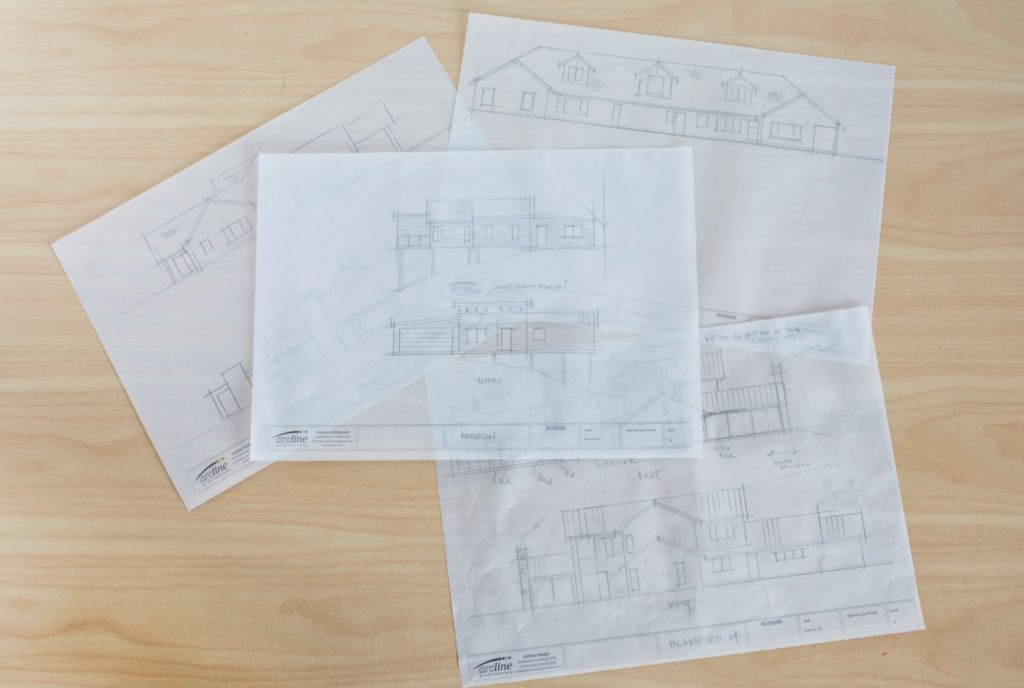It’s helpful to have a few ‘you are here’ signs along the journey to your home, which is why we go over the Architectural Design Process on this page. You can also download our free pdf infographic showing the design process on one page.
The design journey with one company can be completely different to another. The below is a generic indication of the different phases of the architectural design process.
1) Site Visit & Client Ideas
If a picture speaks a thousand words, actually ‘being there’ must be several hundred thousand. A site visit with you is crucial to understanding the site, topography, your feelings, interests and desires. Also, it helps for you to be armed with your design scrapbook (literal or electronic), it could be things found in magazines, Pinterest, Archipro (highly recommended), architects websites or Houzz. Take a look at our 6 best websites for house ideas here.
2) Sketch Concepts
Based on the Site Visit and initial discussions, preliminary sketch concepts including a floor plan, elevations and site plan are prepared with all the site rules and regulations in mind. Having a surveyors topographical plan is crucial and at this stage a Geotechnical engineer is engaged to carry out ground testing to determine the founation options. Following this, sketches are discussed and fine tuned until you’re ready for the design to move to the next stage.
3) CAD Concepts
CAD stands for Computer Aided Design. In this stage the technicians detail your concept plans using architectural computer programs to produce an accurate site plan, floor plan and elevations of your new home. All council rules are checked thoroughly and a build cost estimate can be prepared to ensure the design is running to budget. Here at Arcline we give our clients a full 3D walkthrough of the house, having multiple Virtural Reality and Augmented Reality options to explore the design.


3.5) Resource Consent
It’s as simple as this – if the rules on your site are breached, a Resource Consent is needed (simply speaking). Often, approvals and reports from other parties is needed for the Resource Consent. Neighbors, Fire Emergency NZ, Heritage NZ, Landscape reports, Engineers reports, to name a few. To do a Resouce Consent yourself is super hard and not recommended, however you do not need to be qualified to submit one. Note – not all projects require a resource consent (in our case only around 30% do).
4) Developed Design & Subconsultants
The concept plans are then detailed with cross sections and further detail to the stage engineers, truss designers and other subconsultants can have their input into them. At this point the kitchen design, interior design, wastewater design, stormwater design and other reports can be completed to move the drawings and specifications closer to completion.
5) Full Plans & Specifications
Fully detailed plans and specifications are then completed exactly to your requirements and to the Building Code. Materials and sizes are selected for their optimum use, saving you money and saving the builders’ time. In our case, plans are checked against a 350-point checklist before being issued. These plans are used for consents and construction.
6) Building Consent & Pricing
Now, with all the required documentation gathered the plans are ready to be submitted to the local Council. All items are packaged together according to the requirements of the Council and submitted by email, online, or via hard copy. The consent processing time in New Zealand is 20 working days, however this can vary greatly (we’ve had between 13 days and 52 days!) depending on the council, their workload and the time of year.
7) Construction
After the building consent is issued you’re ready to confirm the build pricing and commence construction. It’s best to choose builders based on recommendations from friends and people in the industry. However, during the build the designer usually remains open for discussion and edits, to ensure the best outcome for all parties.
Download: The Architectural Design Process – Infrographic
Click here or on the below image to download a copy of our architectural design process infographic:
Yes, we’ve only skimmed the surface of the detail involved, but leave that detail to your designer.
That’s why it’s the first thing we research.
Contact our team today to discuss your project.

